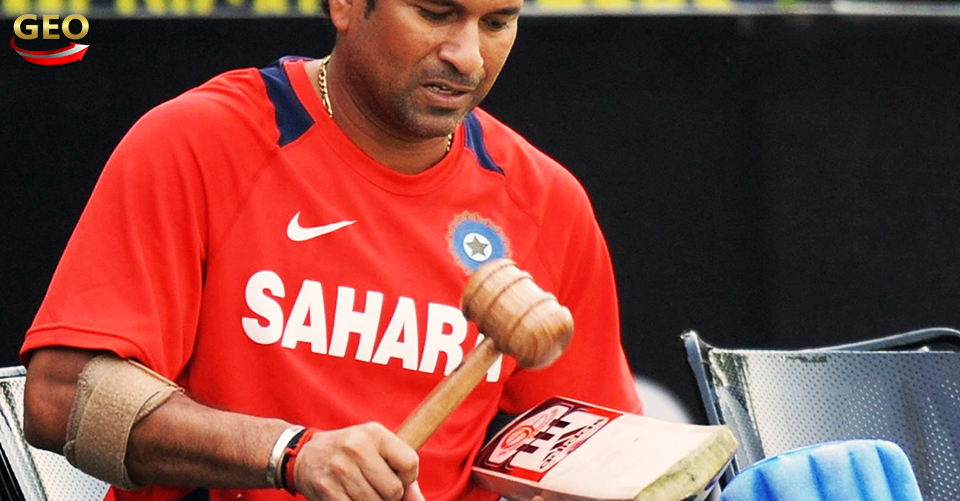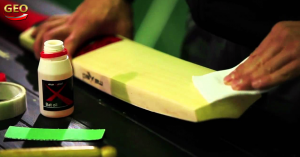
Cricket Bat’s proper preparation and care is the key for a long life of your Bat. Once you have purchased your cricket bat, the next step is to prepare it properly for action and then maintain it.
Cricket Bat Preparation:
Bat Preparation comprises of following two phases:
1. Oiling Your Cricket Bat: In order to oil your bat properly, follow the procedure detailed below:
- Using a soft rag, apply a light coat of oil to the face, edges, toe and back of your bat. Avoid getting oil on the splice of the bat as it may undermine the glue holding the handle and blade of the bat together.
- Avoid over oiling the cricket bat.
- After the coat of oil has been applied, leave the cricket bat in a horizontal position to dry overnight.
- On the next day, apply a second coat, following the same directions as the first one. Leave to dry.
- After oiling the cricket bat, the next phase begins i.e., Knocking In.
- Try and oil your bat regularly to keep the fibres of the wood supple and prevent the face of the cricket bat cracking.
- If applying anti-scuff cover oil only once, very lightly.
As per our experience, over half of the bats sent back for repair, have not been sufficiently oiled or have in turn been over oiled. A balance needs to be struck, with a light coating as the main instruction provided by bat manufacturers. If the cricket bat you have just purchased has an anti-scruff cover, the face will not need oiling. However the back of the cricket bat will need oiling.
- Knocking Your Bat In: After purchase, all cricket bats should be knocked in to prepare them for use in competitive matches. The edges, toe and blade of the bat all need to be sufficiently knocked in, as these areas face large amounts of impact from the cricket ball, therefore making them vulnerable to breakages and damage. Knocking your cricket bat in is an effective way of ensuring that the bat has been compacted enough to prevent impact damage. As the knocking in process is a very important aspect of preparing your cricket bat for action, it cannot be rushed and must be done carefully. Knocking your cricket bat in is effectively ensuring that the wood of the bat is compact as the fibres are compressed and knitted together. In order to knock your bat properly, follow the procedure detailed below:
- Using a hardwood bat mallet, gently strike the face and the edges of the cricket bat, simulating what the ball would do in a competitive game situation.
- Repeat the above on multiple occasions, gradually increasing the power.
- Use the same method as above to round the edges of the cricket bat, but be careful.
- Avoid using too much power to begin with as this could result in unnecessary damage.
- Note: Do not hit the edge directly with the mallet, gradually round the cricket bat It is important to knock the edges of the bat in as they can often be vulnerable to damage during competitive matches and net play.
- After 2-3 Hours of knocking the cricket bat in, you can take it to the nets and hit some short catches using an old ball. If seam marks or small indentations appear on the face of the cricket bat, it would be necessary to return to the first step.
- After continuing to knock the cricket bat in and completing some close catching sessions, you could try the bat in your normal net practice.
- After a few net sessions, your cricket bat should be ready to use in a competitive match.
Added Protection
After knocking your bat in, you must add a protective cover to your cricket bat. This should be positioned and fitted approximately 3-5mm from the toe of the bat, with the cover running up the face of the cricket bat and finishing just below the bat manufacturers labels.
Pre-knocked in Cricket Bats
Bats that come “pre-knocked” in or “pre-prepared” means that the manufacturers have employed some special machine to compress the bats and mimic the “Knocking-in” process. However all manufacturers still recommend cricket bats be knocked in for a short duration. Instead of knocking the bat in for long periods of time using a hardwood bat mallet, you can conduct some short practice slip catches using an old cricket ball. Knocking the face in further will be beneficial in developing the cricket bats overall performance.
Bat Care Top Tips
- Inspect your bat regularly for any signs of damage or dryness due to a lack of oiling. This way you can utilise preventative measures before your cricket bat breaks.
- When in the nets, ensure that the bowlers are using high quality cricket balls as this will avoid damage being caused to your cricket bats.
- Avoid getting the toe of the bat wet during matches and net practice.
- If cracks appear on the face and the edges of the cricket bat, sand them out and apply a covering of oil.
- During the course of a season, sand the blade and edges of the cricket bat twice using sandpaper. Then apply covering oil.
It must be remembered that the cricket ball is supposed to contact the cricket bat’s blade in the middle of the bat. Any occasion where the ball strikes the bottom or edges of the bat is deemed as a bad shot and any resulting damage cannot necessarily be attributed to the blade being faulty.
All cricket bats will encounter some damage when the ball is struck on the edge or bottom. However, it must be accepted that a badly miss-timed shot can cause damage to the bat, and this is usually obvious on examination.
Bat Damages
Cricket bats will break mainly due to the fact that they are manufactured from raw materials and are therefore naturally fragile. When you have purchased a cricket bat it would be nice to think that the bat would last forever, but unfortunately due to the fact that they are manufactured from a natural product they decay as time goes on making them more vulnerable to damage and breakages.
Handle Breaks
This can often be caused through general wear and tear and can therefore sometimes be unavoidable. In some circumstances the handle of the bat can be replaced by some bat manufacturers largely depending on the extent of the damage.
Breakage to the Blade
This can be caused by dry willow. When the willow of the bat becomes dry, the cricket bat is made considerably weaker therefore making it more vulnerable to damage and breakages.
Surface cracks to the Face and Edges
This can be caused by general wear and tear and more often poor bat maintenance. Cracks to the face and edges of the blade will not affect performance but will make the bat more vulnerable to further damage over time. It would be advisable for you to utilise bat tape to prevent any further damage from occurring.
Split Toe
This can often be unavoidable due to the nature of the sport and the sheer impact of the ball hitting the cricket bat. This is often attributed to striking the ball at the base of the blade when facing a Yorker type delivery.
Some of the most common breakage causes with cricket bats are:
- Dry willow
- Letting the bat get wet
- Playing poor shots regularly
- Poor preparation in terms of oiling the bat and knocking it in
- Poor maintenance
- Poor storage
- Excessive oiling
- Using cheap hard balls at net practice
Playing in wet, damp conditions can be detrimental to the quality and performance of your cricket bat, as water is transferred up through the toe and into the bat. When the bat then dries, the bat can be prone to splitting. This can be avoided through using an old bat if you are forced to play in wet conditions or not tapping your bat on the wet ground in your stance.
When using your cricket bat on multiple occasions in a week during the course of a cricket season, the bat can become more prone to the above problems. Therefore it might be advisable to use an old bat at net practices, although many players prefer to maintain on and off-field consistency in order to better reflect match conditions.
Many people store their cricket bats and other pieces of cricket equipment poorly. Your cricket bat should ideally be stored in the shed or the garage where the willow can absorb moisture in a natural environment. Avoid leaving cricket bats in the car, as during the summer months temperatures can rise substantially which can dry the bat and reduce the presence of moisture. You should also avoid storing your bat close to radiators, fires and in airing cupboards.

